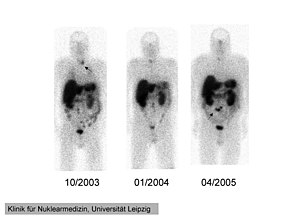| Octreotide scan | |
|---|---|
 111In-pentetreotide scintigraphy of a 41-year-old man with ectopic Cushing's syndrome caused by a neuroendocrine carcinoma of the mesentery. Radiotracer accumulation in the left thyroid in 10/2003 (arrow). The mesenterial neuroendocrine tumor became clearly visible in 4/2005 (arrow). | |
| Synonyms | ocreoscan |
| ICD-9-CM | 92.18 |
| OPS-301 code | 3-70c |
An octreotide scan is a type of SPECT scintigraphy used to find carcinoid, pancreatic neuroendocrine tumors, and to localize sarcoidosis. It is also called somatostatin receptor scintigraphy (SRS). Octreotide, a drug similar to somatostatin, is radiolabeled with indium-111,[1] and is injected into a vein and travels through the bloodstream. The radioactive octreotide attaches to tumor cells that have receptors for somatostatin (i.e. gastrinoma, glucagonoma, etc.). A gamma camera detects the radioactive octreotide, and makes pictures showing where the tumor cells are in the body, typically by a SPECT technique. A technetium-99m based radiopharmaceutical kit is also available.[2][3]
Octreotide scanning is reported to have a sensitivity between 75% and 100% for detecting pancreatic neuroendocrine tumors.[4]
Instead of gamma-emitting 111In, certain octreotide derivatives such as edotreotide (DOTATOC) or DOTATATE are able to be linked by chelation to positron-emitting isotopes such as gallium-68 and copper-64 which in turn can be evaluated with more precise (compared with SPECT) scanning techniques such as PET-CT. Thus, the octreotide scan is now being replaced in most centers with gallium-68 DOTATATE and copper-64 DOTATATE scans. Somatostatin receptor imaging can now be performed with positron emission tomography (PET) which offers higher resolution and more rapid imaging.[5]
- ^ medicinenet.com > Carcinoid Syndrome (cont.) By Dennis Lee and Jay Marks. Retrieved Mars 2011
- ^ Briganti V, Cuccurullo V, Berti V, Di Stasio GD, Linguanti F, Mungai F, Mansi L (30 November 2020). "99mTc-EDDA/HYNIC-TOC is a New Opportunity in Neuroendocrine Tumors of the Lung (and in other Malignant and Benign Pulmonary Diseases)". Current Radiopharmaceuticals. 13 (3): 166–176. doi:10.2174/1874471013666191230143610. PMC 8193811. PMID 31886756.
- ^ Garai I, Barna S, Nagy G, Forgacs A (November 2019). "Limitations and pitfalls of 99mTc-EDDA/HYNIC-TOC (Tektrotyd) scintigraphy". Nuclear Medicine Review. Central & Eastern Europe (in German). 19 (2): 93–98. doi:10.1007/s00117-019-0574-x. PMID 27479887. S2CID 199443705.
- ^ Kwekkeboom DJ, Krenning EP (April 2002). "Somatostatin receptor imaging". Seminars in Nuclear Medicine. 32 (2): 84–91. doi:10.1053/snuc.2002.31022. PMID 11965603.
- ^ Hofman MS, Kong G, Neels OC, Eu P, Hong E, Hicks RJ (February 2012). "High management impact of Ga-68 DOTATATE (GaTate) PET/CT for imaging neuroendocrine and other somatostatin expressing tumours". Journal of Medical Imaging and Radiation Oncology. 56 (1): 40–47. doi:10.1111/j.1754-9485.2011.02327.x. PMID 22339744. S2CID 21843609.
© MMXXIII Rich X Search. We shall prevail. All rights reserved. Rich X Search
